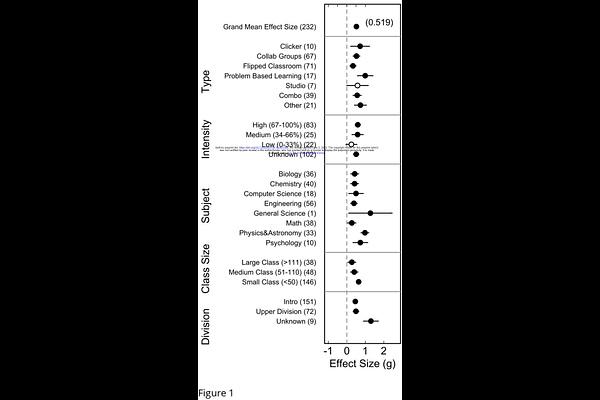Active learnings impact on student course performance in STEM varies by type and intensity

Active learnings impact on student course performance in STEM varies by type and intensity
Xu, S.; Velasco, V.; Hill, M. J.; Tran, E.; Agrawal, S.; Arroyo, E. N.; Behling, S.; Chambwe, N.; Cintron, D. L.; Cooper, J. D.; Dunster, G.; Grummer, J. A.; Hennessey, K.; Hsiao, J.; Iranon, N.; Jones, L.; Jordt, H.; Keller, M.; Lacey, M. E.; Littlefield, C. E.; Lowe, A.; Newman, S.; Okolo, V.; Olroyd, S.; Peecook, B. R.; Pickett, S. B.; Slager, D. L.; Caviedes-Solis, I. W.; Stanchak, K. E.; Sundaravaradan, V.; Valdebenito, C.; Williams, C. R.; Zinsli, K. A.; Freeman, S.; Theobald, E. J.
AbstractWe updated a recent meta-analysis of active learnings impact on student achievement in undergraduate STEM courses by following the same protocol to evaluate studies published from 2010-2017. We screened 1659 papers, coded 1294, and found 210 that met five pre-established inclusion criteria and six pre-established criteria for methodological quality. After further dropping 76 studies with no exam scores data, 134 of these studies contained data on student performance on identical or equivalent exams. We found that on average, active learnings effect size on exam scores was 0.519 {+/-} 0.049, meaning that when students are in active learning classes, they perform roughly half a standard deviation higher on an identical exam. Funnel plots and sensitivity analyses indicated that these results were not due to sampling bias. Active learning had a positive impact on student outcomes regardless of class size, course level, or STEM discipline, though there was heterogeneity in the effects. All of these results are very similar when compared to earlier meta-analyses, however increased resolution in the studies analyzed here revealed two novel results. First, student performance was significantly better in courses that employed high-intensity active learning, defined as students being on task at least two-thirds of class time, versus lower-intensities. Additionally, there was significant heterogeneity in efficacy across different types of active learning employed. These results suggest that most, if not all types of active learning are effective, and that when innovating in their classes, instructors should continually work to increase active learning intensity. We urge caution in interpreting the results on active learning types, however, and propose a preliminary framework for making more-sophisticated and reliable analyses of variation in course design. Finally, the evidence presented here for active learnings impact on student outcomes creates a strong foundation for faculty professional development and administration.